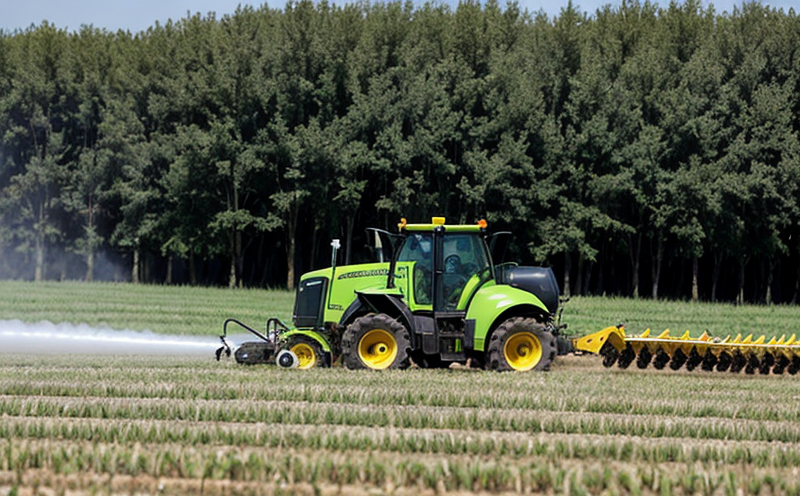Mancozeb Residue Testing in Crops Validation Method Development Test
Mancozeb, a widely used fungicide, plays an essential role in agriculture by controlling fungal diseases. However, its presence in crops above permissible limits can pose health risks and lead to regulatory non-compliance. Eurolab offers comprehensive Mancozeb residue testing services tailored for validation method development tests in crops. Our robust analytical techniques ensure accurate quantification of mancozeb residues, allowing our clients to maintain compliance with international standards.
Validation studies are critical for ensuring that the methods used by laboratories and industries meet regulatory requirements. These studies often involve complex experimental setups where multiple factors need careful control to produce reliable results. Eurolab's expertise lies in providing a holistic approach to validation, encompassing not just analytical testing but also method development support.
The process of validating mancozeb residue testing methods typically includes several key steps: selecting appropriate reference materials, establishing recovery rates, assessing matrix effects, and ensuring precision and accuracy. At Eurolab, we employ state-of-the-art instrumentation such as liquid chromatography-tandem mass spectrometry (LC-MS/MS) which allows for sensitive detection down to parts per billion levels. This ensures that even trace amounts of mancozeb can be accurately measured.
Our method validation services cover a wide range of matrices including leaf tissue, fruit pulp, seeds, and soil samples. Each sample type presents unique challenges due to varying physical properties like moisture content or particle size. To address these differences, Eurolab utilizes standardized protocols recommended by international standards organizations such as ISO 17025:2017 which governs the competence of testing laboratories.
Once validated methods are established, they become crucial tools for monitoring compliance with regulatory limits set forth by authorities like the European Commission's Maximum Residue Levels (MRL) directive or U.S. Environmental Protection Agency guidelines. By adhering strictly to these directives, food producers protect public health while avoiding potential legal penalties.
Eurolab’s commitment extends beyond mere testing; we actively contribute towards improving global agricultural practices through our research and development efforts aimed at enhancing pesticide efficacy without compromising environmental sustainability. Understanding the long-term implications of chemical use in agriculture drives us to continuously refine our methodologies ensuring they remain relevant amidst evolving standards and expectations.
Method Development for Mancozeb Residue Testing
The process begins with selecting suitable reference materials that accurately represent the target compounds. These references are then subjected to various extraction techniques designed to mimic real-world scenarios where residues may be found within crops. The chosen technique must not only extract mancozeb effectively but also minimize interference from other components present in the matrix.
After extraction, clean-up procedures are employed to further purify samples before analysis. Commonly used approaches include solid phase extraction (SPE) columns and centrifugation steps which help concentrate target analytes while removing interfering substances. Following this step, calibration standards are prepared using known concentrations of mancozeb to calibrate the instrument accurately.
Validation studies then proceed by evaluating several parameters critical for ensuring reliable results: linearity (the relationship between measured signal and actual concentration), precision (repeatability and intermediate precision), accuracy (agreement with true values), detection limits, limit of quantification (LOQ), matrix effects, and recovery rates. Each parameter is assessed individually to ensure no aspect compromises overall performance.
Instrumentation Used for Mancozeb Residue Testing
Liquid Chromatography-Tandem Mass Spectrometry (LC-MS/MS) serves as the backbone of our residue analysis. This technique combines high-resolution separations from liquid chromatography with precise ion detection through mass spectrometry. The tandem nature allows for confirmation of both parent ions and product ions, providing robust evidence against false positives.
Other advanced techniques like Gas Chromatography-Mass Spectrometry (GC-MS) are also utilized depending on specific requirements or matrices involved. For instance, when dealing with volatile compounds, GC-MS offers superior sensitivity compared to LC-MS/MS. Additionally, Fourier Transform Infrared Spectroscopy (FTIR) can be employed for qualitative analysis of mancozeb residues.
Sample Preparation Steps
Sample preparation plays a pivotal role in obtaining accurate results during residue testing. Depending on the matrix type, different methods may be applied such as mechanical grinding followed by sieving to achieve appropriate particle sizes suitable for further processing.
- Leaf Tissue: Fresh leaves are harvested under controlled conditions and immediately placed in preservatives to prevent degradation before being transferred to a freezer. Upon return to the lab, samples undergo thorough washing followed by drying and homogenization into fine powders.
- Fruit Pulp: Fully ripe fruits are cut open carefully without exposing them to air which could lead to oxidation. The inside is scooped out gently preserving cell structure as much as possible before proceeding with subsequent steps like drying and milling.
Eurolab Advantages
At Eurolab, we pride ourselves on delivering exceptional services backed by years of experience and cutting-edge technology. Here are some reasons why choosing us for your Mancozeb residue testing needs could be advantageous:
- Comprehensive Methodology: Our team comprises seasoned professionals who understand the intricacies involved in validating pesticide residue testing methods.
- Precision and Accuracy: Leveraging sophisticated equipment like LC-MS/MS ensures precise measurements capable of detecting minute amounts of mancozeb.
- Adherence to Standards: Eurolab strictly follows international standards including ISO 17025:2017 ensuring that our results are acceptable worldwide.
- Client Satisfaction: We prioritize customer needs, offering tailored solutions and transparent communication throughout the project lifecycle.
International Acceptance and Recognition
Eurolab’s methodologies have been internationally recognized for their reliability and accuracy. Our services comply with numerous global regulations:
- European Union (EU) Maximum Residue Levels Directive.
- United States Environmental Protection Agency (US EPA).
- World Health Organization (WHO).
- FAO Codex Alimentarius Commission.
- International Organization for Standardization (ISO).





